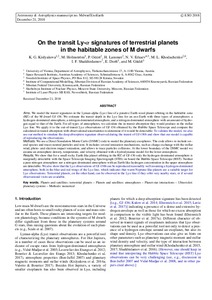Transit Lyman-α signatures of terrestrial planets in the habitable zones of M dwarfs
Скачать файл:
URI (для ссылок/цитирований):
https://www.aanda.org/articles/aa/abs/2019/03/aa33941-18/aa33941-18.htmlhttps://elib.sfu-kras.ru/handle/2311/129824
Автор:
Kislyakova, K. G.
Holmström, M.
Odert, P.
Lammer, H.
Erkaev, N. V.
Khodachenko, M. L.
Shaikhislamov, I. F.
Dorfi, E.
Güdel, M.
Коллективный автор:
Политехнический институт
Кафедра прикладной механики
Дата:
2019-03Журнал:
ASTRONOMY & ASTROPHYSICSКвартиль журнала в Scopus:
Q1Квартиль журнала в Web of Science:
Q1Библиографическое описание:
Kislyakova, K. G. Transit Lyman-α signatures of terrestrial planets in the habitable zones of M dwarfs [Текст] / K. G. Kislyakova, M. Holmström, P. Odert, H. Lammer, N. V. Erkaev, M. L. Khodachenko, I. F. Shaikhislamov, E. Dorfi, M. Güdel // ASTRONOMY & ASTROPHYSICS. — 2019. — Т. 623.Аннотация:
Aims: We modeled the transit signatures in the Lyman-alpha (Ly-α) line of a putative Earth-sized planet orbiting in the habitable zone (HZ) of the M dwarf GJ 436. We estimated the transit depth in the Ly-α line for an exo-Earth with three types of atmospheres: a hydrogen-dominated atmosphere, a nitrogen-dominated atmosphere, and a nitrogen-dominated atmosphere with an amount of hydrogen equal to that of the Earth. For all types of atmospheres, we calculated in-transit absorption they would produce in the stellar Ly-α line. We applied it to the out-of-transit Ly-α observations of GJ 436 obtained by the Hubble Space Telescope (HST) and compared the calculated in-transit absorption with observational uncertainties to determine if it would be detectable. To validate the model, we also used our method to simulate the deep absorption signature observed during the transit of GJ 436b and showed that our model is capable of reproducing the observations.
Methods: We used a direct simulation Monte Carlo (DSMC) code to model the planetary exospheres. The code includes several species and traces neutral particles and ions. It includes several ionization mechanisms, such as charge exchange with the stellar wind, photo- and electron impact ionization, and allows to trace particles collisions. At the lower boundary of the DSMC model we assumed an atmosphere density, temperature, and velocity obtained with a hydrodynamic model for the lower atmosphere.
Results: We showed that for a small rocky Earth-like planet orbiting in the HZ of GJ 436 only the hydrogen-dominated atmosphere is marginally detectable with the Space Telescope Imaging Spectrograph (STIS) on board the HST. Neither a pure nitrogen atmosphere nor a nitrogen-dominated atmosphere with an Earth-like hydrogen concentration in the upper atmosphere are detectable. We also showed that the Ly-α observations of GJ 436b can be reproduced reasonably well assuming a hydrogen-dominated atmosphere, both in the blue and red wings of the Ly-α line, which indicates that warm Neptune-like planets are a suitable target for Ly-α observations. Terrestrial planets, on the other hand, can be observed in the Ly-α line if they orbit very nearby stars, or if several observational visits are available.
Коллекции:
Метаданные:
Показать полную информациюСвязанные материалы
Показаны похожие ресурсы по названию, автору или тематике.
-
Supermassive hot Jupiters provide more favourable conditions for the generation of radio emission via the cyclotron maser instability - a case study based on Tau Bootis b
Weber, C.; Erkaev, N. V.; Ivanov, V. A.; Odert, P.; Grießmeier J.-M.; Fossati, L.; Lammer, H.; Rucker, H. O. (2018)We investigate under which conditions supermassive hot Jupiters can sustain source regions for radio emission, and whether this emission could propagate to an observer outside the system. We study Tau Bootis b-like planets ... -
The Kepler-11 system: evolution of the stellar high-energy emission and initial planetary initial atmospheric mass fractions
Kubyshkina, D.; Fossati, L.; Mustill, A. J.; Cubillos, P. E.; Davies, M. B.; Erkaev, N. V.; Johnstone, C. P.; Kislyakova, K. G.; Lammer, H.; Lendl, M.; Odert, P. (2019-11)The atmospheres of close-in planets are strongly influenced by mass loss driven by the high-energy (X-ray and extreme ultraviolet, EUV) irradiation of the host star, particularly during the early stages of evolution. We ... -
Close-in sub-Neptunes reveal the past rotation history of their host stars: atmospheric evolution of planets in the HD3167 and K2-32 planetary systems
Kubyshkina, D.; Cubillos P. E; Fossati, L.; Erkaev, N. V.; Johnstone C. P; Kislyakova, K. G.; Lammer, H.; Lendl, M.; Odert, P.; Güdel, M. (2019-07)Planet atmospheric escape induced by high-energy stellar irradiation is a key phenomenon shaping the structure and evolution of planetary atmospheres. Therefore, the present-day properties of a planetary atmosphere are ... -
Overcoming the Limitations of the Energy-limited Approximation for Planet Atmospheric Escape
Kubyshkina, D.; Fossati, L.; Erkaev, N. V.; Cubillos, P. E.; Johnstone, C. P.; Kislyakova, K. G.; Lammer, H.; Lendl, M.; Odert, P. (2018-10)Studies of planetary atmospheric composition, variability, and evolution require appropriate theoretical and numerical tools to estimate key atmospheric parameters, among which the mass-loss rate is often the most important. ... -
Spatial Distribution of NDVI Seeds of Cereal Crops with Different Levels of Weediness According to PlanetScope Satellite Data
Pisman, Tamara I.; Erunova, Marina G.; Botvich, Irina Yu.; Shevyrnogov, Anatoly P.; Письман, Т.И.; Ерунова, М.Г.; Ботвич, И.Ю.; Шевырногов, А.П. (Сибирский федеральный университет. Siberian Federal University, 2020-08)The objective of the study is to assess the state of agricultural seeds (level of weediness) on the territory of the Krasnoyarsk Agricultural Research Institute of Federal Research Center «Krasnoyarsk Science Center of ...

